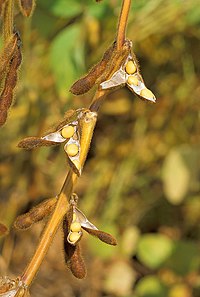
Photo from wikipedia
To study the effect of growth temperature on the nutritional components and metabolites of the wild soybean (Glycine soja), we analyzed the nutritional components and metabolic gases of the wild… Click to show full abstract
To study the effect of growth temperature on the nutritional components and metabolites of the wild soybean (Glycine soja), we analyzed the nutritional components and metabolic gases of the wild soybean in six accumulated temperature regions of the Heilongjiang Province, China, by gas chromatography–time-of-flight mass spectrometry (GC-TOF-MS). A total of 430 metabolites, including organic acids, organic oxides, and lipids, were identified and analyzed using multivariate statistical analysis, orthogonal partial least squares discriminant analysis, principal component analysis, and cluster analysis. Eighty-seven metabolites significantly differed in the sixth accumulated temperature region compared with the other five accumulated temperature regions. The 40 metabolites (such as threonine (Thr) and lysine (Lys)) were found to be elevated in soybeans from the sixth accumulated temperature zone compared with the other five accumulated temperature zones. Through analyzing the metabolic pathways of these metabolites, amino acid metabolism had the greatest influence on wild soybean quality. The results of the amino acid analysis were consistent with those of the GC-TOF-MS and showed that amino acids in wild soybeans from the sixth accumulated temperature zone significantly differed from those of the other zones. Threonine and lysine were the main substances driving these differences. The growth temperature affected the type and concentrations of metabolites in wild soybeans, and the GC-TOF-MS analysis of the effect of growth temperature on wild soybean metabolites was shown to be feasible.
Journal Title: Molecules
Year Published: 2023
Link to full text (if available)
Share on Social Media: Sign Up to like & get
recommendations!